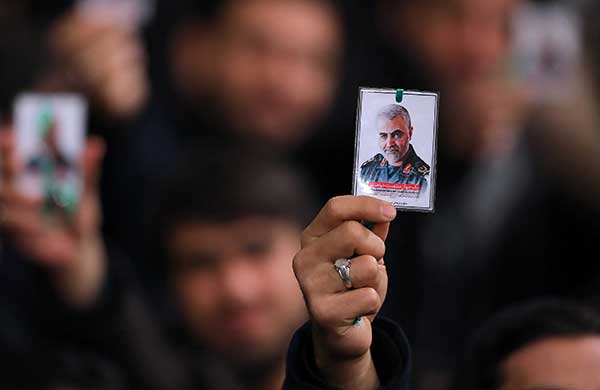Jordan Reimer is a policy analyst at the nonprofit, nonpartisan RAND Corporation.
Last week, international politics was consumed with the potential for all-out war between the United States and the Islamic Republic of Iran, or the possibility of a protracted asymmetric conflict, in response to the killing of the Iranian general Qasem Soleimani. In the Middle East, the United States was caught unsteady, with the (temporary?) cessation of anti-ISIS operations in Iraq and Syria, the prospect of a withdrawal of U.S. forces from Iraq and silence from U.S. regional allies who are usually vocal in pushing back against Iran.
It’s hard to remember that late last year, it was Iran that was knocked back on its feet in the region. It faced significant protests at home as well as in Iraq and Lebanon, where thousands rallied against Tehran’s regional hegemony. Iran found itself facing tremendous bottom-up pressure, with potentially devastating consequences to its regional influence and even domestic stability.
However, due to Iranian machinations and the fallout over the killing of Soleimani, that pressure has been greatly reduced. Yes, the regime is now dealing with renewed protests at home over the downing of a Ukrainian passenger plane, but unlike previous protests they are not countrywide. More importantly, whether Iran will once again face pushback against its malign regional behavior is yet to be determined.
“Iran has been able to turn back the tide at home.”
In the Middle East, it has become a cliché to say that Iran controls four Arab capitals: Baghdad, Beirut, Damascus and Sanaa. But the protests late last year challenged that assertion entirely. First, it should be said that the Iran-backed government in Syria is still fighting to reclaim much of the country, and in Yemen the Houthis’ long-term prospects for control over the government are unlikely.
But more importantly, the protests in Lebanon and Iraq uniformly called for a new, nationalist politics, one not dominated by a sectarianism that benefits Iran. As Lebanese and Iraqis protested their own governments and governance systems, they were inherently challenging the power of Hezbollah and other pro-Iranian parties and affiliated militias. On the streets of Iraq, shouts demanded “Iran get out, get out,” as protesters violently attacked Iranian consulates in Karbala and Najaf.
Meanwhile, inside Iran, after the government announced without warning that it was raising the price of gasoline, mass protests broke out across the country, resulting in the most brutal government crackdown since the Islamic Revolution in 1979. In an effort to salve the protesters’ ire, even the Ayatollah, who normally denounces protests as foreign plots, granted the honorary distinction of “martyr” to protesters who were killed.
In the ensuing weeks, however, Iran was able to turn back the tide at home, in Lebanon and in Iraq. It quickly dispatched the oil subsidy protests, shutting down the internet entirely to prevent the situation from spiraling out of the regime’s control. And regionally, it unleashed its supporters to muddle protests in a miasma of violence and chaos.
In Lebanon, Hezbollah and Amal supporters attacked several protest camps, leading to clashes with security forces. And in Iraq, a “climate of paranoia and fear” became increasingly apparent as protesters and activists were killed, kidnapped or attacked by masked gunmen, leading to the lynching of a teenager by anti-government protesters, sapping their legitimacy. Part and parcel of Iran’s violent chaos strategy were the frequent rocket attacks against U.S. forces in Iraq launched by pro-Iranian militias, which killed an American contractor and set off the chain of events that led to the killing of Soleimani.
Thus, facing the greatest challenge to its regional position in years, Iran was desperate to change the conversation. With the Soleimani attack, as the U.S., Iran and the region contemplated the outbreak of full-blown war, Iran’s goal was achieved.
“Iran appears to have regained its footing.”
There is an indefinite delay to replace the Iran-backed prime minister in Iraq, though he formally submitted his resignation in November. Protesters on the streets of Baghdad have been replaced by mourners rallying around the flag to denounce the death of the deputy commander of the Popular Mobilization Forces who was killed in the U.S. strike that killed Soleimani. And in Lebanon, though protesters likewise succeeded in toppling their prime minister, the prime minister-designate is actually more closely aligned with Hezbollah. Meanwhile, protests in Lebanon have dwindled (although that may be changing).
Iran appears to have regained its footing. However, that is not to say that it has done so for good. The renewed series of protests at home are likely to continue, particularly as the “maximum pressure” campaign on its economy continues. And though protests have receded in Iraq and Lebanon, the lack of any structural reforms means that discontent with governance structures will once again bubble over, as it did in both countries as far back as 2015.
As the latest flare-up may be entering a de-escalatory phase, the U.S. could still push back against Iran, effectively and without the threat of war, by doing what it can to ensure that a key goal of the protests is met: removing Iran’s disproportionate influence in Iraq and Lebanon. This would mean ensuring that the demands of protesters for accountable, nation-above-party governments are met, along with any needed constitutional reforms, without necessarily overthrowing the constitutional systems themselves.




